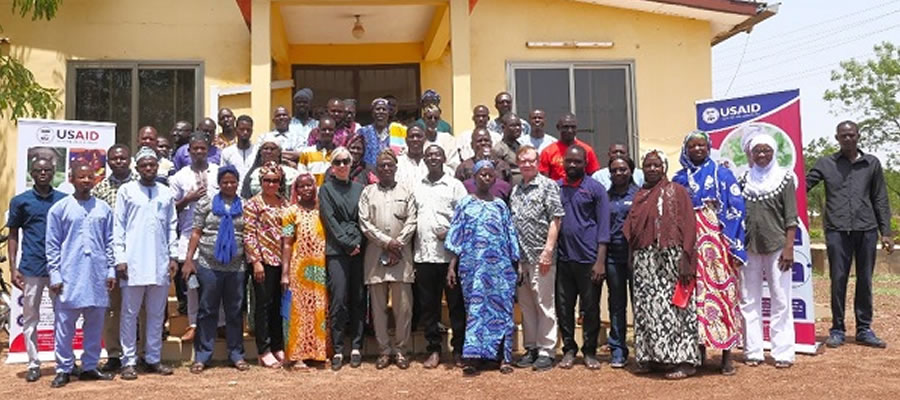

Development Goal, Projections, Objectives And Strategies
Goals are broad statements of intent expressing desires, which are geared towards improving the well being of the people. Since local communities are the beneficiaries or other wise of any development effort in the Assembly, it is extremely important to consider their goals and aspirations which were generated from their harmonized Community Action and Area Level Plans in the design of programmes and projects. The Savelugu Municipal goal, which was informed by the above mentioned process was formulated to guide all sectors of development as outlined in the three {3} thematic areas of the GPRSII and in consonance with the development planning guidelines of the NDPC.
The key development issues are the concerns, which impede the development efforts. The underlying principle therefore is identifying and removing the factors, which inhibit development in order to make development efforts yield positive results. Dealing with the inhibiting factors of development is therefore the focus of the Assembly. The SNDA Goal is developed in the context of the National goal. To bring to the fore this linkage, the National goal, which is drawn from the GPRSII is herein stated.
National Development Goal
The Nations Development Goal is to achieve accelerated and sustainable shared growth, poverty reduction, and promotion of gender equity, protection and empowerment of the vulnerable and the excluded within a decentralized democratic environment.
Development Goal
The Savelugu Municipal aims at improving the quality of life of the people through accelerated access to quality education and health care delivery system, vigorous expansion in social, economic and political infrastructure and improve agricultural production in the context of a sound and sustainable environmental management practices and within a broader grassroots participation in decision making in the development process.
Development projections
In keeping development priorities and the goal, projections have been made to serve as input into the formulation of the sector goals, objectives and strategies to achieve the overall goal. The projections were made using the exponential model and taking into consideration assumptions in various sectors of the development. The development thresholds of the various sectors were also taken into consideration.
Population Projection
The population of the municipality was projected based on the following assumptions:
Current fertility rate averages…….
Current growth rate is 3%
Fertility rate is expected to reduce due to improvement in access to quality health care delivery system
Reduction in mortality rate
Net migration would be negative
Using the United Nations Statistical Organization Exponential Model, the 2009 population is projected as follows:
Pt = PoE (rt)
Where Pt = Projected population =2009
Po = Base year population =2000
E = Natural Log (Constant) =2.718
R = Population growth rate = 3%
T = Census period-time laps = 9 years
Thus: Pt = PoE{rt}
= 91415 x 2.718(3%) 9
= 91415x 2.718 (0.03) 9
= 91415x 2.718(0.27)
= 91415x 1.309927779
= 119747.0479
= 119747 approximately
It could be seen from the above that the population of Savelugu Municipal be 119747 comprising 61,071(51%) female and 58,676 (49%) male by 2009. In order to determine the service requirements by 2009, the thresholds of the various services were identified.:
Projection of Service/Facilities Requirements by 2009
The service/facilities requirements were projected on the basis of the following among other things:
Current Population {2006} = 109,442 {Projected}
Male = 53,627
Female = 55,815
Future Population {2009} = 119,747
Potentials, Opportunities Constraints and Challenges (POCC)
A critical analysis of potentials, constraints, opportunities and challenges was conducted to assess the POCC of the Savelugu Municipal in relation to the above priorities.
Application of Potentials, Opportunities, Constraints and Challenges (POCC) The Savelgu Municipal outlined a number of development problems, potentials and constraints for which proposals to address them were made to stimulate the Assembly’s development. Given the changing economic dimensions over the years, it is important for the Municipal to review the proposals made in that respect and identify current opportunities and potentialities which should be mobilized for the Municipal’s development; as well as constraints and Challenges that should be minimized through specific interventions.
Identified priority issues based on the prioritized needs and aspirations are further subjected to the analysis of the Potentials, Opportunities, Constraints and Challenges (POCC) of the Municipal with respect to each of the goals of the NMTDPF 2018-2021. This enhanced the formulation of appropriate strategies for more implementation-oriented plans.
Municipal Development Goal
Goals are anticipated desired state, which reflects a general improvement from a weak or poor state to a better one in the medium term to long them. Thus, goals are broad statements of intent expressing desires, which are geared towards improving the wellbeing of the people.
The Municipal goal formulated as per the Guidelines of the NMTDPF reflects the national goal of the NMTDPF 2018-2021. In this regard, having in mind the current situation, the needs and aspirations of the municipal, the municipal’s goal for the 2018-2021 plan periods is geared toward “Strengthening institutions through the development of the human resource to facilitate services delivery to accelerate sustainable production, growth of various sectors, poverty reduction and enhance accountability and transparency to the citizens”.
Goal Compatibility Analysis In order to ascertain as to the degree of compatibility of the municipal’s goal and that of the nation, there needs to be a compatibility analysis of these two goals. This is to ensure that the achievement of the municipal’s goal would in the long run aid in the achievement of the national goals of:
Build a prosperous society that will create an opportunity for all, Safeguard the natural environment and ensure a resilient, build environment that Maintain a stable, united and safe society and Strengthen Ghana’s role in international affairs.
The municipal’s goal is strongly compatible with the national goals. This in essence gives an indication that the achievement of the municipal’s goal would undoubtedly lead to the achievement of the national development goals for the 2018-2021 plan periods.
Implementation, Monitoring and Evaluation
Monitoring matrix or results framework outlining all indicators, their baselines and targets.
It is extremely prudent that adequate measures are put in place to keep track of the implementation of the various initiatives and projects embodied in this document. The decentralized development framework
adopted by the country and for that matter the implementation of Medium Term Development Plan demands a participatory approach.
As a result, monitoring and evaluation will start right with the communities, the Unit Committees, Assembly Persons and the District assembly. This is to ensure that activities are timely and efficiently implemented.
The objectives for the monitoring and evaluation include;
- To ascertain whether project implementation are on track or not and to take corrective measures as to when and where it is necessary
- Gather periodic data for future planning purposes
- Identify successful interventions for replication in other parts of the district
Monitoring of Physical Projects
The monitoring and evaluation would be based on the guidelines given by the National Development Planning Commission (NDPC) for monitoring project execution of physical projects at the district level. The project monitoring team will therefore comprise the following;
- Municipal Coordinating Director
- Municipal Planning Officer Municipal Budget Officer
- Municipal Works Engineer
- Municipal Finance Officer
- Municipal Gender Desk Officer
This team will assist to monitor the execution of programmes and projects within the plan. Each monitoring visit will also include the Head of department the project falls under including the Assembly person of the project location.
Reporting on Monitoring Activities
Being an integral part of the plan implementation, monitoring will involve both the process and the approach. Monitoring will start from the initial phase through to the final evaluation. Participatory methodology will be the main tool for the monitoring process and will involve all stakeholders at different levels and on regular basis.
At the Municipal level, the MPCU is responsible for undertaking monitoring and evaluation activities together with the sector agencies. The MPCU is specifically responsible for the design of monitoring and evaluation procedures as well as monitoring and evaluation plans. Again it is required to provide an oversight overall district level monitoring and evaluation of district development programmes.
Unlike monitoring, evaluation will be conducted in greater detail at the project level. Ex-post facto evaluation will be carried out purposely to assess whether the resources invested have produced or are producing the desired results in terms of impacts, and whether the benefits are reaching the intended target beneficiaries.
After each monitoring exercise, project actors, communities and sector departments involved will be made aware of the key observations and findings. The MPCU will also brief the MCE, Presiding member and other MA actors on progress of work, observation and gaps identified. This will allow all stakeholders to take the necessary action that require redress before the next monitoring exercise. The DPCU includes all the findings and reactions in its Quarterly and Annual Progress Reports. The Annual Progress Report will sum up all the M & E activities in the year. The M & E report will be disseminated to relevant stakeholders and decision makers.
The monitoring and evaluation of the plan will use the already existing structures at the Municipal level and will be integrated into the overall monitoring and evaluation plan of the Municipal.
Besides the periodic monitoring activities, the Municipal Assembly shall also hold mid-year review of the Annual Action Plan (AAP) and Budget to ascertain the following:
The level of progress made in the implementation of the AAP and Budget Status of programmes, projects and activities outstanding programmes and projects and how relevant they are to the Municipal’s development How far programmes and projects are meeting set goals Identify programmes and projects that can be rolled over to the following year.
Monitoring Indicators
One of the critical steps in preparing the M&E plan is defining the most appropriate indicators and targets that are achievable and directly related to the DMTDP goal and objectives. Municipal specific indicators based on the DMTDP are determined through a participatory and collaborative process. The indicators are specific, Measurable, Attainable, Reliable and Time bound (SMART). The core and district specific indicators are also:
- categorized into input, output, outcome or impact indicators
- Disaggregated (where possible) by age, gender, communities, etc.
- information on how it will be measured and by whom
- Indication on the frequency of monitoring
- targets set for the DMTDP implementation period 6) baselines (they should be established where they do not exist)
- Targets of what can be achieved by 2017 as well as annual targets
Date Created : 11/18/2017 8:10:37 AM










 facebook
facebook
 twitter
twitter
 Youtube
Youtube
 +233 593 831 280
+233 593 831 280 0800 430 430
0800 430 430 GPS: GE-231-4383
GPS: GE-231-4383 info@ghanadistricts.com
info@ghanadistricts.com Box GP1044, Accra, Ghana
Box GP1044, Accra, Ghana